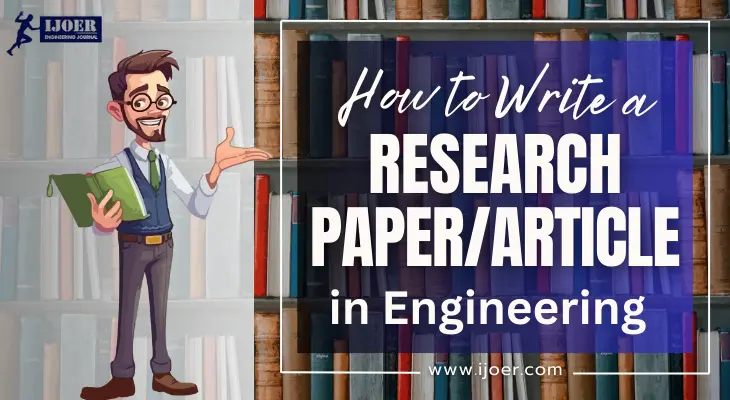
Writing a research paper in engineering is an essential step for sharing innovations, solving real-world problems, and contributing to technological progress. Whether you're a student, academic, or professional, a well-structured paper can boost your academic profile and open doors to collaborations and career growth.
In this blog, we’ll walk you through each step of writing a high-quality engineering research paper - from choosing a topic to final submission.
Every great research paper begins with a strong idea. Selecting the right topic is one of the most important decisions you’ll make in your research journey. It shapes the direction, depth, and impact of your work.
Start with a topic that:
Tip: Review recently published papers in journals like IJOER to spot knowledge gaps or emerging areas in your field.
Understanding what’s already been discovered lays the groundwork for your research. A literature review not only prevents duplication but also helps you build upon established knowledge and refine your research focus.
Explore:
Organize the reviewed studies under themes or categories and summarize what has been done, what remains unanswered, and how your work will contribute.
A clear problem statement gives purpose to your research. Without it, your study may lack direction or relevance. Clearly defined objectives guide your methodology and help readers understand what you aim to achieve.
Focus on:
Make sure your objectives are SMART – Specific, Measurable, Achievable, Relevant, and Time-bound.
Methodology is the blueprint of your research. It outlines how your study will be conducted, ensuring that your findings are reliable, replicable, and valid.
Decide:
Document each step clearly so others can reproduce or verify your research if needed.
Data is the backbone of engineering research. The way you gather, organize, and interpret data determines the accuracy and credibility of your results.
During this phase:
Check for consistency and address any anomalies in your dataset.
Now it’s time to put everything together. A research paper is not just a collection of data—it’s a structured presentation of your journey, findings, and insights.
Follow this common engineering paper format:
Even strong research may be rejected due to poor formatting. Each journal has its own set of submission rules, and adhering to them shows professionalism and increases your chances of acceptance.
Always check:
Download the “Author Guidelines” from the journal’s website before formatting.
Before you hit submit, polish your paper. A well-written, error-free paper reflects attention to detail and enhances readability.
Check for:
You can also use editing tools (like Grammarly) or ask a colleague to proofread.
Originality is a must in academic publishing. Engineering journals, including IJOER, are strict about plagiarism. Submitting non-original or improperly cited content may lead to rejection or even academic penalties.
Use tools like:
Ensure all referenced work is properly cited using the journal’s preferred style guide.
Your paper deserves the right platform. Choosing a reputable, indexed journal ensures your work reaches the intended audience and contributes to the global body of knowledge.
For engineering research, IJOER (ISSN: 2395-6992) offers:
Check submission deadlines, fees (if any), and publication timelines before submitting.
Writing a research paper in engineering may seem challenging at first, but with a structured approach, it becomes a powerful tool to share your innovations. Take time to research, write, review, and revise — and always aim to contribute meaningfully to the global engineering community.
Ques. 1: What is the ideal length of an engineering research paper?
Ans.: Most engineering research papers range between 4,000 to 7,000 words, including references and figures. However, the ideal length depends on the journal’s submission guidelines. Always check the formatting rules before writing.
Ques. 2: Can undergraduate students publish engineering research papers?
Ans.: Yes, undergraduate students can publish if the research is original, well-documented, and contributes to the field. Many journals, including IJOER, encourage young researchers to publish under the guidance of a mentor or professor.
Ques. 3: How do I choose the right journal for my engineering paper?
Ans.: Look for journals that:
Ques. 4: How do I make sure my research paper is not rejected?
Ans.: To improve your chances of acceptance:
Ques. 5: Is it necessary to include references in a research paper?
Ans.: Absolutely. References show that your research is based on established knowledge and help avoid plagiarism. Use only credible sources and cite them using the journal’s preferred citation style (e.g., IEEE, APA).
Ques. 6: What is the peer review process in engineering journals?
Ans.: In peer review, your paper is evaluated by experts in the field to check:
Ques. 7: Can I use AI tools to help write or edit my paper?
Ans.: Yes, AI tools like Grammarly or QuillBot can help improve grammar, structure, and clarity. However, do not use AI to generate entire content, as most journals check for originality and authorship integrity.

|
Citation Indices
|
All
|
Since 2020
|
Citation |
2359 |
1680 |
h-index |
19 |
15 |
i10-index |
57 |
24 |
|
Acceptance Rate (By Year)
|
|
|
Year
|
Percentage
|
|
2023
|
9.64%
|
|
2027
|
17.64%
|
|
2022
|
13.14%
|
|
2021
|
14.26%
|
|
2020
|
11.8%
|
|
2019
|
16.3%
|
|
2018
|
18.65%
|
|
2017
|
15.9%
|
|
2016
|
20.9%
|
|
2015
|
22.5%
|